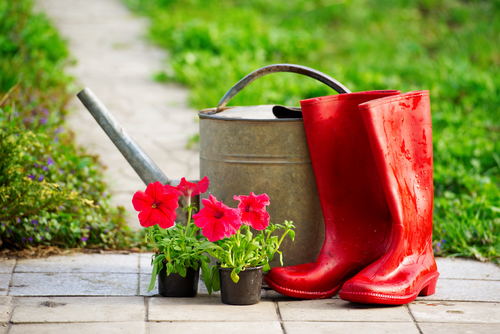

Paul Hardaker - on what his garden can tell us about Climate
Summer is the time that you can sit back in your garden and think that all those spring weekends of hard work sorting out the borders was worth it. But if you’re like me you spend about five minutes enjoying the fruits of your labours (sometimes literally) before you spot the next gardening job that you have to get on with. This makes me think particularly of the beech tree we have in our garden; beautiful, imposingly tall and from the width of the trunk looks like it’s been a local resident of the area for longer than any of the houses that are now built around it. As much as I enjoy my century old tree there are at least three times in the year that I curse its presence. In the autumn it unceremoniously deposits some thirty black sacks of leaves, hey but who’s counting, which I dutifully rake up and then shred for my compost bin. Then in spring I have a heavy dusting if the strangest green powder that resembles a light snowfall with several thousand strange fury wind-pollinating catkins. Finally, and possibly the least desirable is the shower of beech nuts. I’m told they are edible although because of the high tannin content are very bitter in taste. I’ve never tried one, being more of a cashew-man myself.
So why am I rambling on about my beech tree, I am sure you are asking yourself by now. Well since I have been the proud custodian of this tree, some seven years now, I have been interested in looking at how these different stages of my tree’s behaviour changes from one year to the next. What those in the scientific world call phenology; not to be confused with the similarly named phrenology, the study of bumps on the head! Phenology is the study of plant and animal life-cycles, much of which is driven by the seasons, and perhaps more specifically the transition between those seasons and the changing sunshine, temperature and rainfall.
The founding father of phenology is Robert Marsham who began recording his 'Indications of Spring' back in 1736 on his family estate near Norwich, Norfolk. More generally phenological records have been kept in the UK by many gardeners going back to the 1800s, but the longest record I know of is on European grape harvests that go back over 500 years. From 1891 until 1948 the Royal Meteorological Society published the annual phenological records for the UK, a fascinating dataset that is still actively used today. In 2000 Kew Gardens established the Kew 100. As it says on Kew’s phenology website:
… the aim of recording annually the first-flowering and mid-flowering dates of 100 plants in the Gardens in perpetuity. The range of plants chosen comprises native plants such as Meadow Saxifrage and Cow Parsley, naturalised introduced species like the Bluebell and many exotic species from the collections such as Egyptian Willow and Star Magnolia. It spans trees, shrubs, perennials and bulbs providing a representative selection of the outdoor plants that grow at Kew.
In 2010 the Woodland Trust in partnerships with the Centre for Ecology and Hydrology began a programme called ‘the nature’s calendar survey’ where people can both record their observations and look at records of 250 years of first flowering from 405 different species.
What the survey shows is that Britain’s plants are flowering five days earlier for every one degree rise in temperature and that on average plants flowered between 2 and 12 days earlier over the last 25 years compared with any other consecutive 25 year period, a signal from nature of our changing climate and something that many gardeners have witnessed first hand.
We often talk about climate and how this is changing on a global or country-wide scale but we don’t often hear much about it in relation to what’s happening in the garden. Believe it or not gardens can have their own climate (what we call a micro-climate), and it’s possible to change the micro-climate of your garden and hence change the nature of how your garden uses water, plant growth and flowering by clever planting, by a planned use of light and shade, and whether or not you decide to chop down a century-old beech tree!



